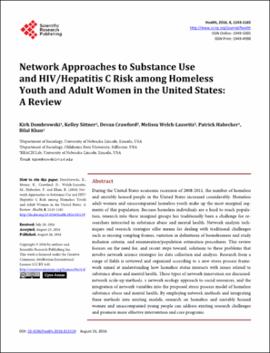| dc.contributor.author | Dombrowski, Kirk | |
| dc.contributor.author | Sittner, Kelley | |
| dc.contributor.author | Crawford, Devan | |
| dc.contributor.author | Welch-Lazoritz, Melissa | |
| dc.contributor.author | Habecker, Patrick | |
| dc.contributor.author | Khan, Bilal | |
| dc.date.accessioned | 2022-02-15T20:42:48Z | |
| dc.date.available | 2022-02-15T20:42:48Z | |
| dc.date.issued | 2016-08-26 | |
| dc.identifier | oksd_sittner_networkapproachestosubstanceuse_2016 | |
| dc.identifier.citation | Dombrowski, K., Sittner, K., Crawford, D., Welch-Lazoritz, M., Habecker, P., & Khan, B. (2016). Network approaches to substance use and HIV/hepatitis C risk among homeless youth and adult women in the United States: A review. Health, 8(12), pp. 1143-1165. https://doi.org/10.4236/health.2016.812119 | |
| dc.identifier.uri | https://hdl.handle.net/11244/334609 | |
| dc.description.abstract | During the United States economic recession of 2008-2011, the number of homeless and unstably housed people in the United States increased considerably. Homeless adult women and unaccompanied homeless youth make up the most marginal segments of this population. Because homeless individuals are a hard to reach population, research into these marginal groups has traditionally been a challenge for researchers interested in substance abuse and mental health. Network analysis techniques and research strategies offer means for dealing with traditional challenges such as missing sampling frames, variation in definitions of homelessness and study inclusion criteria, and enumeration/population estimation procedures. This review focuses on the need for, and recent steps toward, solutions to these problems that involve network science strategies for data collection and analysis. Research from a range of fields is reviewed and organized according to a new stress process framework aimed at understanding how homeless status interacts with issues related to substance abuse and mental health. Three types of network innovation are discussed: network scale-up methods, a network ecology approach to social resources, and the integration of network variables into the proposed stress process model of homeless substance abuse and mental health. By employing network methods and integrating these methods into existing models, research on homeless and unstably housed women and unaccompanied young people can address existing research challenges and promote more effective intervention and care programs. | |
| dc.format | application/pdf | |
| dc.language | en_US | |
| dc.publisher | Scientific Research Publishing, Inc. | |
| dc.relation.ispartof | Health (Irvine Calif), 8 (12) | |
| dc.relation.uri | https://www.ncbi.nlm.nih.gov/pubmed/28042394 | |
| dc.title | Network approaches to substance use and HIV/hepatitis C risk among homeless youth and adult women in the United States: A review | |
| dc.date.updated | 2022-02-09T17:50:01Z | |
| osu.filename | oksd_sittner_networkapproachestosubstanceuse_2016.pdf | |
| dc.description.peerreview | Peer reviewed | |
| dc.identifier.doi | 10.4236/health.2016.812119 | |
| dc.description.department | Sociology | |
| dc.type.genre | Article | |
| dc.type.material | Text | |
| dc.subject.keywords | Homeless Women | |
| dc.subject.keywords | Homeless Youth | |
| dc.subject.keywords | Network Ecology | |
| dc.subject.keywords | Network Science | |
| dc.subject.keywords | Racial/Ethnic Health Disparities | |
| dc.subject.keywords | Stress Process Models | |
| dc.rights.license | https://creativecommons.org/licenses/by/4.0/ | |
| dc.relation.oaurl | https://pubmed.ncbi.nlm.nih.gov/28042394/ | |
| dc.identifier.author | ORCID: 0000-0002-8588-4487 (Sittner, Kelley) | |
